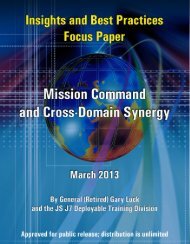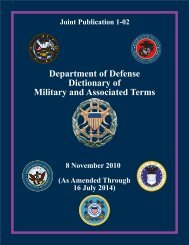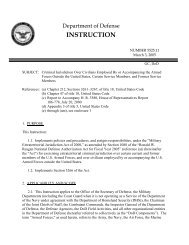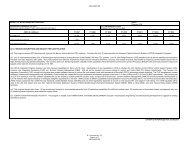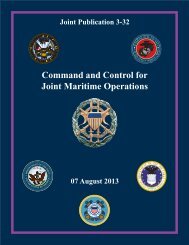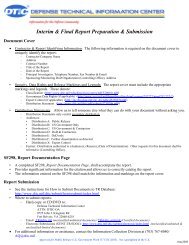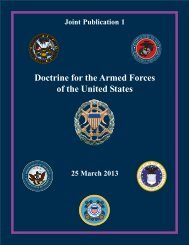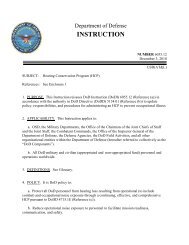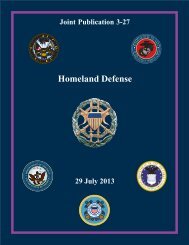JP 3-16, Multinational Operations - Defense Technical Information ...
JP 3-16, Multinational Operations - Defense Technical Information ...
JP 3-16, Multinational Operations - Defense Technical Information ...
Create successful ePaper yourself
Turn your PDF publications into a flip-book with our unique Google optimized e-Paper software.
Planning and Execution Considerations<br />
b. NATO CIMIC. Within NATO, CMO is often referred to as CIMIC. CIMIC refers<br />
to “the resources and arrangements which support the relationship between commanders and<br />
the national authorities, civil and military, and civil populations in an area where military<br />
forces are or plan to be employed.” Such arrangements include cooperation with<br />
nongovernmental or international agencies, organizations, and authorities.<br />
c. Generally, CIMIC expands on CA activities that refer primarily to support of the civil<br />
component of the OE in order to influence the civilian environment in support of the armed<br />
forces. While CIMIC and CA activities often overlap on the ground, there is a clear<br />
doctrinal difference in scope. While CA encompasses activities undertaken to establish and<br />
maintain relations between military forces and civil authorities as well as the general<br />
population, CIMIC focuses on humanitarian need and provides guidance for how to interact<br />
with civilian actors (civil authorities, local populations, international organizations, and<br />
NGOs) to effectively complete the objectives of a humanitarian mission. CA, by contrast,<br />
focuses on military needs and provides suggestions for how to gain the support of civilians<br />
for the military mission. Whereas CIMIC and CA forces have similar roles, the CA forces<br />
have a much broader function and different focus than most CIMIC organizations. Despite<br />
these noticeable distinctions between CA and CIMIC, the two approaches share sufficient<br />
common ground to be compatible.<br />
d. CIMIC doctrine involves aspects of both CMO and interorganizational coordination<br />
as described in joint doctrine. Additionally, CIMIC teams are comprised of a mixture of<br />
military and civilian members, much like a provincial reconstruction team.<br />
See A<strong>JP</strong>-3.4.9, Allied Joint Doctrine for Civil-Military Cooperation, for additional<br />
information.<br />
NORTH ATLANTIC TREATY ORGANIZATION<br />
CIVIL-MILITARY COOPERATION (CIMIC)<br />
Thirteen North Atlantic Treaty Organization (NATO) nations directly<br />
commanded twenty-seven active provincial reconstruction teams (PRTs)<br />
simultaneously engaged in a variety of sixty-four CIMIC operations and<br />
projects scattered throughout Afghanistan. Coordinating this significant<br />
presence of widely dispersed international assistance personnel is one of<br />
the tasks of NATO’s <strong>Multinational</strong> CIMIC Group (MNCG) Headquarters<br />
established in 2009. MNCG is able to engage CIMIC activities to support<br />
NATO and multinational operations, to enhance the effectiveness of military<br />
operations and serve as an essential forum for CIMIC consultations,<br />
planning staff, and a center of expertise. MNCG’s Deployable Module or<br />
implementation detachments provide the permanent specialist core able to<br />
coordinate any kind of CIMIC effort as well as provide consultancy and<br />
advice to the force commander.<br />
MNCG ensures that although flexible and different from each other, all PRTs<br />
share the same NATO CIMIC mission and the same operational/strategic<br />
III-35



